
Roof-Mounted Watersport Carriers
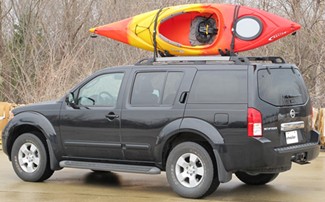
With a rooftop watersport carrier, you can easily load and transport:
As with most roof-mounted accessories, one of the main reasons for transporting your gear on your vehicle's roof is a lack of cargo space within your vehicle. Even if you have a fairly large truck or SUV, you may not be able to fit boards in with the rest of your cargo. And just imagine trying to find room for a boat.
You can transport almost any large piece of watersport gear on the roof of your vehicle. A specialty roof rack is all you need to easily load and secure kayaks, canoes, surfboards, or paddleboards. Most of these racks are designed to easily attach to the crossbars of a roof rack, though foam block kits will allow you to carry items on a naked roof.
Don't have a roof rack?
If your vehicle doesn't have a roof rack, click here to search our large selection of roof racks to find a custom-fit model for your vehicle's roof.
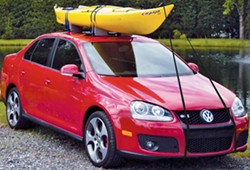
Roof-Mounted Kayak and Canoe Carriers
As most enthusiasts know, it can be difficult - if not impossible - to fit a canoe or kayak into your SUV or truck bed. One of the most popular and convenient methods for transporting these types of boats is to mount them to your vehicle's roof. There are a few different types of roof-mounted boat carriers to choose from. The following table will help you differentiate a bit among them based on what each carrier can do for you.
| Does it... | Foam Block Kits | Saddle Carriers | J-Style Cradles | Stacking Systems | Rollers | Load-Assist Carriers | Hitch-Mounted Support Systems | Canoe-Specific Systems |
|---|---|---|---|---|---|---|---|---|
| Require roof-rack crossbars? | No | Yes | Yes | Yes | Yes | Yes | No* | Some |
| Require that my boat be lifted onto the roof? | Yes | Yes (unless paired with rollers) | Yes | Yes | No | No | Yes | Yes |
| Provide enough security for long trips and extended highway driving? | No | Yes | Yes | Yes | No | Yes | No | No |
| Provide protection for fiberglass and other composite boats? | No | Only when used with felt-like pads | Yes | No | No | Yes | No | Yes |
| Let you carry more than one kayak at a time (based on vehicle width)? | Yes 2 Sets must be purchased | Yes - 2 Sets must be purchased | Yes - 2 Sets must be purchased | Yes | Yes - 2 Sets must be purchased | No | No | No |
| Help make positioning and tie-down easy? | No | No | No | No | Yes | Yes | No | No |
| Work with a pickup truck? | No | No | No | No | No | No | Yes | No |
*You must either mount a single crossbar (DTA968) to your vehicle's roof or use a foam block kit and position one of the blocks on your roof.
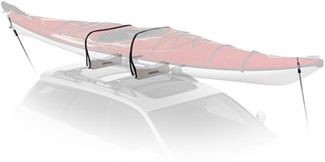
Foam blocks are basic tools to help you securely carry your canoe or kayak on your vehicle's roof. Most blocks can be mounted either directly to a naked roof or to roof-rack crossbars. Made of durable foam, these blocks provide a soft, contoured area for your boat to rest on. Once you have your kayak properly positioned on the blocks, just tie it down securely with straps.
These blocks provide an affordable alternative to a complete kayak loading and carrying system. If you only kayak on occasion and you don't have to go far to put in, then this system is perfect for you. However, foam blocks do not provide the most secure fit, and they are not therefore designed for long-distance travel or long-term use.
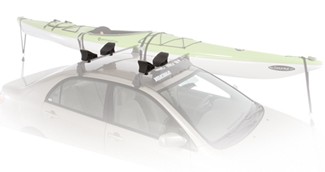
Similar in concept to foam blocks, kayak saddles mount to your roof-rack crossbars to provide a cushioned, secure area for your boat to sit on. These cradles are far more adjustable than blocks, and therefore they can better conform to your boat's hull for added security.
As with foam blocks, this system requires that you lift your boat onto your roof and manually position it. You may have to adjust the distance between the saddles to ensure that they appropriately cradle your kayak. You can load and unload canoes and kayaks easiest on saddles that use rollers or non-grip surfaces like felt that allow you to slide your watercraft on and off from the rear.
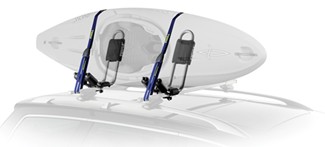
This type of carrier holds your kayak on its side, taking up less room on top of your roof so that you can carry additional accessories on your roof rack (provided that your setup is wide enough to accommodate those accessories). The J-shaped cradles mount to your roof-rack crossbars and combine with tie-down straps to hold your boat in place.
J-cradles are great for both plastic and composite boats. Because you won't be sliding your kayak into place, as you do with saddle systems, you don't have to worry about scratching the gel coat on composite hulls. The bigger concern with this type of carrier is whether or not you can easily lift your kayak into place, especially after paddling all day.
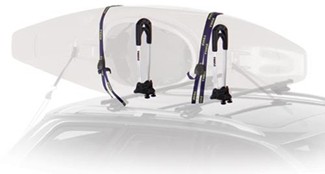
With stack-style racks, all you have to do is mount the included posts to your roof-rack crossbars, and then you can secure two kayaks - one on either side of the posts - with tie-downs. As long as you tie your equipment down appropriately, this system will hold your kayaks in place for the long haul.
Because it does not incorporate cradles or padded sections, a stacker may not be the best carrier for composite boats. You can, however, purchase pads that will add a bit of cushion between your boat and the roof-rack crossbars. This type of system is most often used for white-water kayaks.
These carriers have rollers that mount onto your rear roof-rack crossbar, taking the place of a rear set of kayak saddles. These rollers make it easy to slide your boat onto and off of your vehicle's roof and also serve as cradles for transport.
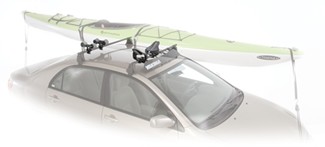
Rollers provide adequate stability when paired with a good set of saddles, but because they do not conform to your boat's hull, they may damage composite kayaks.
Load-Assist Systems
Load-assist systems are great for all enthusiasts. If you aren't quite strong enough to lift your kayak onto your roof by yourself, particularly after a long day of rowing, then a load-assist system is likely exactly what you've been searching for. And even if you are strong enough to load and position your boat, wouldn't it be nice to never have to strain to do it?
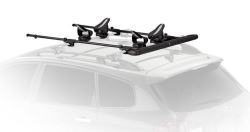
Yakima's ShowBoat 66 provides a simple solution for loading your heavy or unwieldy kayak. Mount the ShowBoat to the outside of your carrier, which is sold separately, and slide it out over the rear of your vehicle. It adjusts side to side for perfect positioning. Just line your kayak up with your saddles and slide it into place. The ShowBoat does most of the work for you: balancing, supporting and positioning your boat for perfect placement.
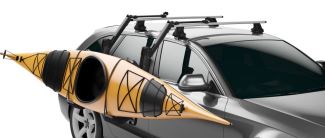
Thule's Hullavator is one of the most innovative load-assist systems out there. With this carrier you can load your kayak from the side of your vehicle and at waist-level. Tie your boat down to the integrated cradles with the included straps and then position the entire thing back into place on your roof rack with virtually no effort.
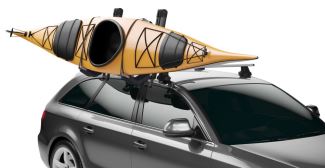
The Hullavator has heavy-duty gas struts that take the effort out of lifting and positioning your kayak onto your roof. When you pull the carrier down from the roof, whether empty or loaded, it will move in a controlled and easy fashion. And when you lift it back onto your roof, all you have to do is give it a nudge in the right direction and it will rise and secure into place.
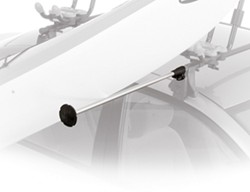
If you're looking for a more economically priced option, or something that is less bulky, try the Thule Outrigger II, the Yakima BoatLoader, the Rhino-Rack Universal Side Loader, or the Inno Kayak Lifter. The Thule and Yakima extension pieces install in your roof-rack crossbar and telescope out to help you load your boat from the side of your vehicle. The Rhino-Rack Side Loader clamps to your front crossbar and has a telescoping leg that provides additional support. The Inno Kayak Lifter clamps to your crossbars and has an arm that you can pivot out when you want to load a canoe or kayak. To use these load assists, just place the front of your canoe or kayak on the bar and pivot it upward. The extra support that the extension bar provides keeps you from having to lift the entire weight of the boat to position it on your carrier.
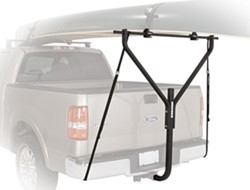
Perfect for pickup trucks with trailer hitch receivers, hitch-mounted supports provide a crossbar-like extension at the rear of your vehicle. With this add-on, you can mount a kayak, canoe or various other equipment and materials to your roof. Turn the extension into a kayak carrier by mounting a foam block kit. Just position one block on the extension and the other on top of your truck's cab. For extra support and stability, mount a single crossbar on the roof of your truck and then place the foam block on the bar.
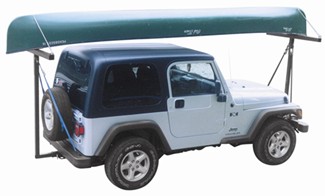
If you have a Jeep with trailer hitch receivers at both the rear (for towing and accessory attachment) and the front (for a winch), you can use two hitch-mounted supports to create a boat carrier for a vehicle that would otherwise require a trailer to transport a canoe.
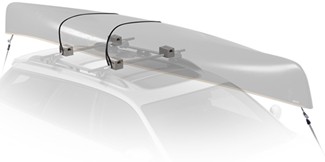
Some carriers are designed specifically for canoes or can work with canoes and other types of watercraft. Canoes should be mounted upside down so that the gunwales support its weight. This positioning can be achieved by using either specially designed brackets that mount to your roof-rack crossbars and provide an area for your boat to rest on, or by using foam blocks. These foam blocks are similar to kayak blocks in that most can be used either with or without a roof-rack system, but instead of using two blocks to cradle the hull at either end of your boat, you use four blocks to support the boat by its gunwales.
Roof-Mounted Surfboard and Paddleboard Carriers
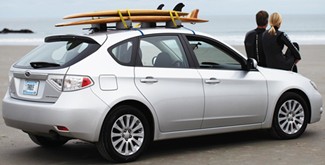
Sure you could probably toss your boards in the back of a pickup or SUV. Of course they could easily get scratched, cracked or otherwise damaged while bouncing around back there. And do you really want a wet, sandy mess in your cargo area?
A roof-mounted surfboard or paddleboard carrier is an obvious choice for someone who has a car with limited cargo space, but it provides a secure, space-saving alternative for those with larger vehicles as well. Surfboard carriers and paddleboard carriers are safe and typically easy to use.
Click here, to see our surfboard carriers.
Click here, to see our paddleboard carriers.
Roof-Rack Compatibility
Many surfboard and paddleboard carriers are designed to mount to the crossbars of your roof rack. Most feature clamping mechanisms that are nearly universal and can attach to either round, square, elliptical or aero bars. As always, though, be sure to read through the product descriptions carefully to determine roof-rack compatibility of each carrier.
Tie-Down Systems
Several different tie-down systems are available to help make it easier to transport surfboards and paddleboards. Some of these systems have features that make it easier to load boards. Many have locking clamps and tie-down straps to help prevent theft. And the straps on most of these tie-down systems are integrated into the system's clamps or crossbars, so they're not in your way and can't get lost.
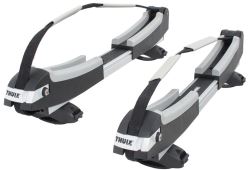
The Thule SUP Taxi and SUP Shuttle tie-down systems offer adjustable pads that provide just the right fit for your boards. The pads also help prevent damage to the finish of your boards. Both of these systems clamp onto most crossbars. The Thule SUP Taxi is designed for security - the straps and the clamps lock, and the straps are made of webbing reinforced with steel cable.
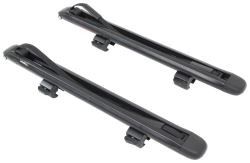
The sleek SUPDawg and SupPup by Yakima offer protective rubber support for your boards. Both of these tie-down systems clamp to most crossbars and have integrated straps that are easy to tighten. The SUPDawg also has rollers that make it easy to slide your surfboard or paddleboard onto the carrier from the side. The SUPDawg's clamps and steel-reinforced straps lock for security.
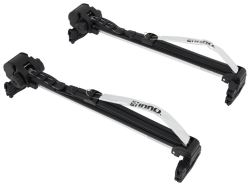
Inno offers several tie-down systems. The straps on most Inno carriers include cranes - arms that hold the straps up and out of the way to make it easier to load your cargo. Inno carriers can clamp to almost any crossbar shape, but the INXA445 attaches to T-channels. Most Inno carriers can lock, and the straps are reinforced with stainless steel cable. More than surfboard and paddleboard carriers, many of the Inno systems double as canoe and kayak carriers.
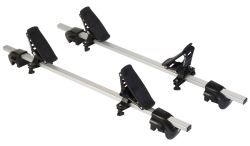
The Swagman Rincon consists of saddle style pads that clamp to most types of crossbars. The saddles pivot to help you load your cargo from the side. These saddles also work great for securing a kayak.
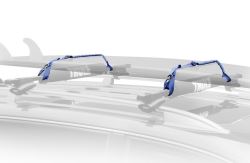
Basic Tie-Downs and Pads
If you don't want to invest in a tie-down system, you can use tie-down straps and pads to secure a paddleboard or surfboard to your roof rack. Pads can provide a soft cushion for your board, protecting it from scratches and dents that can occur if it slides or bounces against your crossbars. Tie-down straps with padded buckles can hold your board to your crossbars, and ropes or straps with S-hooks can secure the ends of your boards to your vehicle's bumpers or other anchor points. Thule offers the Express Surf Strap, a tie-down that is specifically made for boards.
How to Tie-Down Your Kayak
Many roof-mounted carriers come with tie-down straps to secure your canoe or kayak for travel. If your system does not include tie-downs, you will need to purchase them separately.
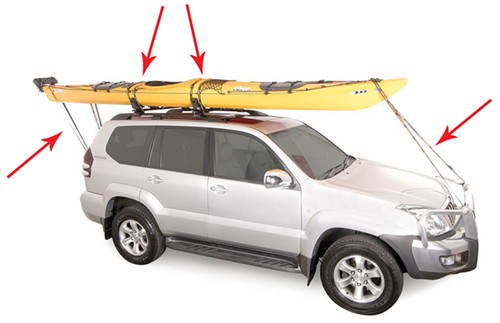
The following tie-down method is intended for kayaks that are mounted in an upright position with the cockpit facing skyward. Whether you are using foam blocks or kayak saddles, the tie-down method is essentially the same.
- Load your kayak onto the roof of your vehicle. Position it onto the blocks or saddles so that the bow points forward as
straight as possible, parallel with your vehicle. This will reduce wind drag.
- You may have to adjust the distance between your saddles to get them to conform to the hull of your particular boat.
- Pass the tie-down straps over the kayak, typically where the saddle or foam blocks sit. Some saddles and blocks have small cutouts to run the
straps through. Try to position the tie-downs over the widest points of your kayak.
- If your kayak is sitting on a roof rack, run the straps around the crossbar on which it is sitting.
- If you are securing the kayak to a naked roof, run the straps into your vehicle, around the roof.
- Tighten the straps to create a snug fit. The straps should be just tight enough so that the kayak barely wiggles if you push it side to side. Do not overtighten.
- Secure the bow with either rope or a bow/stern tie-down. Loop the rope around the bow and through the front grab handle (if possible), and then
run it down to your vehicle's front bumper to hook it in place. Do the same in the rear to secure the stern.
- If there is not an easily accessible point to hook the tie-down to - either on the bumper or your vehicle's frame - or if you want a shorter rope run, you can install a set of tie-down loops beneath your vehicle's hood to serve as anchor points.
- Tighten the bow and stern tie-downs just enough to remove any slack. There should be some downward pressure on both the bow and stern to hold the kayak in place but not so much as to warp the shape of your boat.
- Tie-off any loose ends.
- Check your kayak after driving for a few miles to make sure that it hasn't shifted and that no straps have loosened.
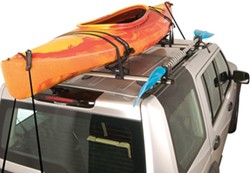
Tips for Transporting Your Watercraft
Tie-Downs
The most important thing to remember when tying down your kayak is to resist the urge to overtighten the straps.
- Tie-downs should be snug with no slack.
- Some downward pressure is expected as the boat conforms to the foam blocks or plastic saddles.
- The shape of your kayak should not distort at all. Overtightening your tie-down straps can warp or even crack your kayak.
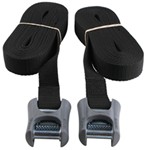
Choose tie-downs wisely. There are many types of tie-downs that are easier to use and, in some cases, better for your equipment than standard ropes.
- Cam-style tie-downs tighten and secure easier than rope, and with these straps, there's no need to learn and remember how to tie different knots. These straps won't automatically tighten as much or as quickly as ratcheting straps either, so there is less risk of overtightening your tie-downs.
- Ratcheting bow and stern tie-downs make tightening a snap. The ratcheting pulley lets you tug tie-downs taut quickly and easily. No need for knots.
- Web-type straps won't dig into your kayak as much as rope. The wide, flat surface area of these straps better distributes the force that is applied when they are tightened down.
- Many tie-down straps and systems include padded buckles or rubberized hooks to offer non-scratch protection.
Composite Hulls
There are special considerations when it comes to transporting composite boats. The construction of these boats is not as forgiving as the durable plastic of many kayaks.
- Take care when tying down composite boats. They do not have as much give as plastic models, and as a result, they may crack if too much pressure is applied during the tie-down process.
- The gel coat on certain composite boats is very easily scratched. Certain saddle systems should not be used with these boats. Make sure that your saddles are appropriately cushioned and lined with a soft, felt-like material, like that found on the Thule DockGlide saddles. Even smooth plastic surfaces can scratch the gel coat.
- Because composite materials are more prone to scratches and cracks, make certain that your boat is secure on its carrier. If you are using saddles, be sure to use a complete set of four saddles, rather than one set of saddles up front and rollers in the rear. Rollers do not provide enough surface area to properly support composite boats.
- Consider using a J-style carrier for composite kayaks. Most provide enough security and support for this type of hull.
Add-On Accessories
If you have a tall vehicle or if you simply have trouble reaching your roof to secure your boat, invest in an accessory step. There are a variety of step options available to help you easily access your roof.
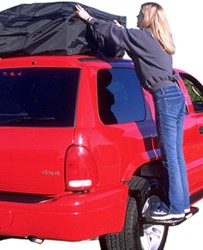
- A hitch-mounted step simply slides into your trailer hitch receiver opening to provide a platform for you to easily access your vehicle's roof from the rear. This can help you get a better angle when hoisting your boat onto your roof, as well as making it easier to reach your boat for securing.
- A wheel step mounts to your vehicle's tire. It is easy to use and typically easy to store so that you can bring it with you in your trunk or cargo area.
Nerf bars, running boards and hoop steps
- If you don't feel stable simply standing on the sill plate of your vehicle, side steps are an excellent alternative. These custom-fit running boards, nerf bars and hoop steps install permanently on your truck or SUV, so they are a bit more of a commitment than a removable step, but they are much easier to use.
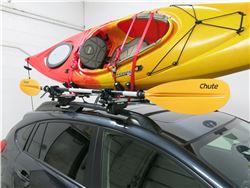
Instead of tossing your dirty paddles into your cargo area, mount them beside your boat on your roof rack. Accessory holders are made to attach to your roof-rack crossbars to hold your paddles securely in place.
Updated by: Raymond P.
Last updated: 9/6/18
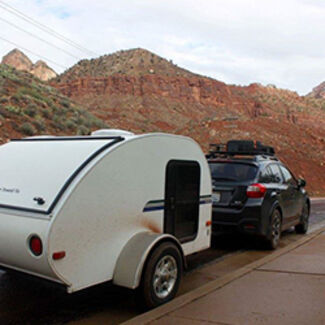
Roger
10/28/2022
I have a 2022 sonata limited and want to be able to carry 2 kyacks on the roof. I have a naked roof

Francis W.
5/15/2022
I have a 21 Yukon with no cross bars just the two bars that run front to back. What do I need for two kayacks with the J mounts?


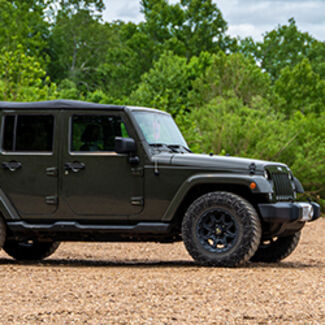
Chari
9/18/2021
I want to haul two kayaks on top of a Jeep Grand Cherokee L with the Thule Hullavator Kayak Carrier. My car has factory installed flush mounted rails. Which cross bars should I buy?
Departments
Towing
- Trailer Hitch
- Fifth Wheel
- Gooseneck
- Towing a Vehicle
- Front Hitch
- RV Hitch
- ATV Hitch
- HD Truck Hitch
- Vehicle Wiring
- Brake Controller
- Ball Mounts
- Weight Distribution
Sports and Recreation
Trailer Parts
- Utility Trailer
- Boat Trailer
- Landscape Trailer
- Enclosed Trailer
- 5th/Camper Trailer
- Car Hauler
- Horse Trailer
Vehicle
Contact & Help

Popular Vehicles
- Subaru Forester
- Ford F-350 Super Duty
- Ford F-250 Super Duty
- Chevrolet Silverado 1500
- Jeep Wrangler Unlimited
- Jeep Wrangler
- Ram 3500
- Toyota Highlander
- Ram 2500
- Chevrolet Silverado 2500
- Subaru Outback Wagon
- Chevrolet Silverado
- Dodge Ram Pickup
- GMC Sierra 2500
- Ram 1500
- Ford F-250 and F-350 Super Duty
- Jeep Grand Cherokee
- Toyota Tacoma
- GMC Sierra 3500
- Toyota Tundra
- Ford Escape
- More >>


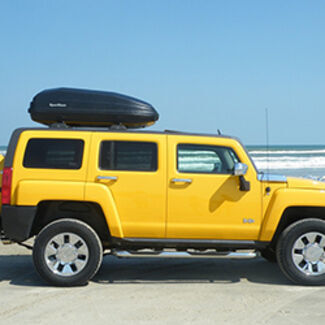


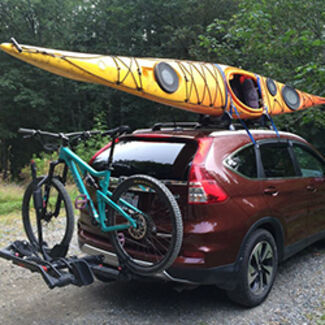




















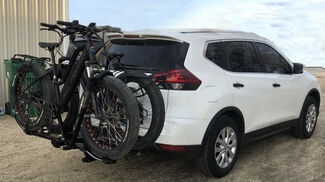




Karen
5/1/2023
Love a recommendation for a 2021 Jeep Wrangler Willy roof rack and kayak carrier for one or two kayaks.